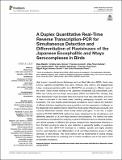Por favor, use este identificador para citar o enlazar a este item:
http://hdl.handle.net/10261/221347COMPARTIR / EXPORTAR:
 SHARE SHARE
 CORE
BASE CORE
BASE
|
|
| Visualizar otros formatos: MARC | Dublin Core | RDF | ORE | MODS | METS | DIDL | DATACITE | |

| Título: | A duplex quantitative real-time reverse transcription-PCR for simultaneous detection and differentiation of flaviviruses of the Japanese encephalitis and Ntaya serocomplexes in birds |
Autor: | Elizalde, Maia; Cano-Gómez, Cristina; Llorente, Francisco; Pérez-Ramírez, E. CSIC ORCID; Casades-Martí, Laia CSIC ORCID; Aguilera-Sepúlveda, Pilar; Ruiz-Fons, Francisco CSIC ORCID ; Jiménez-Clavero, Miguel Ángel CSIC ORCID ; Fernández-Pinero, Jovita | Fecha de publicación: | 2020 | Editor: | Frontiers Media | Citación: | Frontiers in Veterinary Science 7: 203 (2020) | Resumen: | High impact, mosquito-borne flaviviruses such as West Nile virus (WNV), Usutu virus (USUV), Japanese encephalitis virus (JEV), Tembusu virus (TMUV), and Bagaza/Israel turkey meningoencephalomyelitis virus (BAGV/ITV) are emerging in different areas of the world. These viruses belong to the Japanese encephalitis (JE) serocomplex (JEV, WNV, and USUV) and the Ntaya serocomplex (TMUV and BAGV/ITV). Notably, they share transmission route (mosquito bite) and reservoir host type (wild birds), and some of them co-circulate in the same areas, infecting overlapping mosquito and avian population. This may simplify epidemiological surveillance, since it allows the detection of different infections targeting the same population, but also represents a challenge, as the diagnostic tools applied need to detect the whole range of flaviviruses surveyed, and correctly differentiate between these closely related pathogens. To this aim, a duplex real-time RT-PCR (dRRT-PCR) method has been developed for the simultaneous and differential detection of JE and Ntaya flavivirus serocomplexes. The method has been standardized and evaluated by analyzing a panel of 49 flaviviral and non-flaviviral isolates, and clinical samples of different bird species obtained from experimental infections or from the field, proving its value for virus detection in apparently healthy or suspicious animals. This new dRRT-PCR technique is a reliable, specific and highly sensitive tool for rapid detection and differentiation of JE and Ntaya flavivirus groups in either domestic or wild animals. This novel method can be implemented in animal virology diagnostic laboratories as screening tool in routine surveillance and in the event of bird encephalitis emergence. | Versión del editor: | https://doi.org/10.3389/fvets.2020.00203 | URI: | http://hdl.handle.net/10261/221347 | DOI: | 10.3389/fvets.2020.00203 | E-ISSN: | 2297-1769 |
| Aparece en las colecciones: | (IREC) Artículos (INIA) Artículos |
Ficheros en este ítem:
| Fichero | Descripción | Tamaño | Formato | |
|---|---|---|---|---|
| duplexbird.pdf | 652,18 kB | Adobe PDF |  Visualizar/Abrir |
CORE Recommender
PubMed Central
Citations
6
checked on 14-abr-2024
SCOPUSTM
Citations
9
checked on 11-abr-2024
WEB OF SCIENCETM
Citations
10
checked on 24-feb-2024
Page view(s)
170
checked on 16-abr-2024
Download(s)
169
checked on 16-abr-2024

